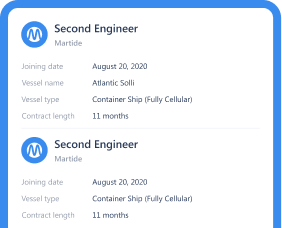Why LinkedIn Can be a Better Maritime Recruitment Tool than a Resume
Nov 05, 2019 · 10 mins read ·
Maritime Recruitment
Are you a shipowner or manning agent who is tired of how sorting through endless seafarer resumes is slowing your maritime recruitment processes down? Do you worry that the information contained in the CVs for shipping companies you receive might not be the truth and nothing but the truth?
If so, you’re not alone.
Staff in Human Resources and management across virtually all industries, not just the maritime industry, are increasingly turning to alternative ways to vet their candidates. Is it time for you to join them?
Why LinkedIn is better than a resume in maritime recruitment
The day of the humble maritime resume is drawing to a close.
Do you remember the days when you’d print out multiple copies of your resume and physically post them to prospective employers?
It seems light years ago now doesn’t it? But in this day and age, those two A4 sides of paper - whether electronic or not - are proving to not be a very effective gauge of a candidate’s true talents.
Why it’s time to retire seafarer resumes in maritime recruitment
Actually, make that Why It’s Time to Retire the Resume in ANY Recruitment! The fact is, in this hectic world, who really has time to sit down and painstakingly read all those resumes (and cover letters) that candidates have forwarded in the hope of being selected for your vacant maritime jobs or contracts?

And even if you do have the time (and the inclination) what’s to say that what a candidate has chosen to write is an honest and accurate portrayal of their experience, skills and qualifications?
This is precisely why recruiters, headhunters, employers, manning agents and HR people are looking at other ways to find qualified candidates for their industries.
Goodbye maritime resume. Hello...what’s next?
You may have heard how Artificial Intelligence is currently one of the hottest tech buzzwords being used in the same sentence as recruitment and HR. In fact, companies such as L’Oreal are already using A.I. to assess candidates.
They’ve found it to be a far more accurate way of getting to know a person through factors such as their speech patterns and even admitted that some of their top new recruits wouldn’t have made it through their doors without it.
But adopting Artificial Intelligence is probably a long way off for the average small to medium-sized shipping company so, realistically, what other tools could be implemented for candidate assessment instead?
One way to dispense with resumes is to conduct your initial screening of applicants through LinkedIn.

The benefits of LinkedIn for applicant assessment
Today’s job seeker is more likely to ensure their LinkedIn profile is up-to-date than the seafarer resume stored in a Word document on their laptop or PC.
This is especially true of seamen looking for new contracts in the maritime industry as they are more likely to have access to the LinkedIn app on their smartphone than documents on a computer.
Related: How to Use Social Media to Up Your Maritime Recruitment Game
LinkedIn profiles are also far easier to compare with one another thanks to their identical formatting. That’s something that the resumes created by different individuals just can’t compete with.
Particularly when you take into account that there is no globally standardized format for a resume for a seafarer. What might be standard in the Philippines could be completely different to a CV written by a Ukrainian or a Brit, and vice versa.
A LinkedIn profile is also just that: a profile containing information about a candidate’s work experience and qualifications. That means you can skip reading all those cover letters too!

The knock-on effect? Your time to hire is quicker and the quality of the candidates you select to move forward at this initial stage will be improved.
LinkedIn is public so people are less likely to lie
Here’s a slightly shocking, but perhaps not that surprising statistic: 46% of people who were asked in a survey whether they knew someone who had lied on their resume said yes.
Break those results down and it showed that fibbing about job experience made up for 76% of lies while duties performed came in at second place with 55%. That’s a big deal!
Needless to say maritime recruitment processes are more rigid than your average office or retail job interview: having the correct documentation and qualifications is a must for a start.
But how can you really know whether or not your seafaring candidates aren’t embellishing the truth just a little bit?
In the maritime industry, taking on an employee or contractor who is unable to perform the job that you hired them to do is no laughing matter.

So why are LinkedIn profiles likely to be more truthful than a resume?
Because they can be seen by any number of people - not just the recruiter or interviewer. And that potentially includes a candidate’s current employer and their colleagues or fellow crew members. The fear of being ‘called out’ over falsehoods ensures that not all, but most, people with a LinkedIn profile are less likely to lie.
LinkedIn can remove a recruiter’s bias
In the same way that Artificial Intelligence aims to remove bias from the candidate selection process, LinkedIn can do the same - albeit in a slightly less high-tech way!
Just as your seafaring candidates from around the globe may format their maritime resumes differently, making it harder for you to read and compare them with one another, so too can the type of information included in a seafarer resume vary.
This means that a typical resume for a seafarer could include very little personal information other than a name and contact details - or it could contain everything from the applicant’s marital status and gender to their religion, hobbies and more.
Related: 5 Risks of Using Social Media to Screen Candidates for Seafarer Jobs
As a professional networking site, LinkedIn does not allow this sort of personal info to be included in a profile. That means that if you are working in marine recruitment and you wish to remove any issues surrounding bias or even prejudice, turning to LinkedIn for screening could be a step in the right direction.
Security is paramount in the maritime industry
Finally, there’s the annoying little matter of cyber security to address. You know how important maintaining a secure posture is throughout the shipping industry, whether you’re a deck cadet, ship’s master or working in maritime recruitment.

Consider that the majority of resumes you receive are sent as email attachments and you’re increasing your chances of getting attacked by a virus or some other nasty form of malware.
Is the seafarer resume really dead?
In all honesty, probably not just yet.
Maritime recruitment agencies, manning agents and employers are still requesting them. But due to the nature of their weaknesses, it may suit you better to use a website like LinkedIn to do your initial screening. That way you’ll be more likely to make the right choice when it comes to selecting candidates.
And you’ll also be able to spot any inconsistencies on their resume when comparing it to their LinkedIn profile.
Martide makes maritime recruitment quicker and easier
And don’t forget that Martide also makes the entire sourcing, interviewing and hiring of candidates far easier too.
Seafarers looking for jobs at sea must first register an account with us and then upload all of their personal details, documents and qualifications. Only when that has been done can they then apply for your vacant maritime jobs.
Our system’s user-friendly design allows you to easily view a candidate’s profile and the seafarer jobs they’ve applied for so you can determine if they are the right fit for your position.
We might be biased but we think it’s a far quicker and more efficient way of filling your jobs at sea and shortening your time to hire - all without a resume for a seafarer in sight!
Want to learn more about Martide’s streamlined and secure recruitment and crew management software solution? Get in touch with us today - we’d be more than happy to schedule a demo with you!

Eve Church
Eve is Martide's content writer, publishing regular posts on everything from our maritime recruitment and crew planning software to life at sea. Eve has been writing professionally for more than two decades, crafting everything from SEO-focused blog posts and website landing pages to magazine articles and corporate whitepapers.
UK



